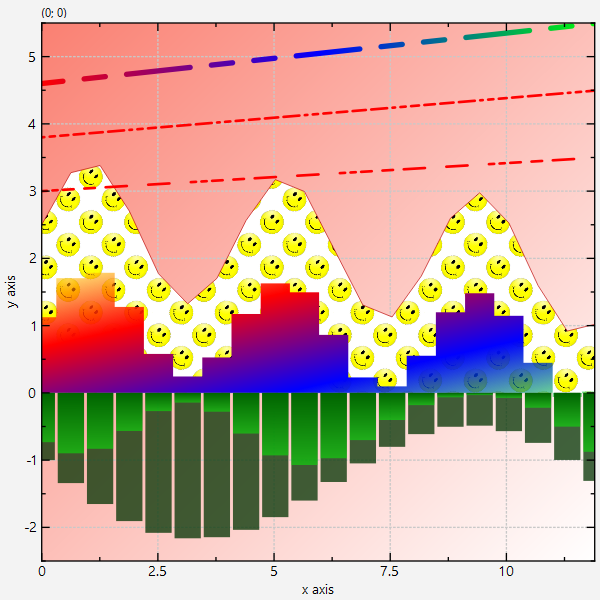| .. | ||
| advplotstyling_and_lib.pro | ||
| advplotstyling.cpp | ||
| advplotstyling.pro | ||
| advplotstyling.qrc | ||
| CMakeLists.txt | ||
| example.bmp | ||
| README.md | ||
Example (JKQTPlotter): Advanced Line and Fill Styling
This project (see ./examples/advplotstyling/) demonstrates how to use advanced line styling and filling options (e.g. custom dash-styles, gradient, image fills, transparencies, ...) with JKQtPlotter.
The source code of the main application can be found in advplotstyling.cpp.
Initially several data columns are generated and added to the internal datastore. Then several line graphs are added that all use different custom dashes. In addition the third line does not use a single color, but a gradient for coloring:
JKQTPGeoLine* graphL1=new JKQTPGeoLine(&plot, 0, 3, 12, 3.5, Qt::red);
JKQTPGeoLine* graphL2=new JKQTPGeoLine(&plot, 0, 3.8, 12, 4.5, Qt::red);
JKQTPGeoLine* graphL3=new JKQTPGeoLine(&plot, 0, 4.6, 12, 5.5, Qt::red);
// 5.2 set advanced line style (see also https://doc.qt.io/qt-5/qpen.html#setDashPattern)
// and use a gradient-brush to fill the last (thicker) line
QVector<qreal> dashes1;
dashes1 << 2 << 2 << 2 << 2 << 4 << 4 << 4 << 4 << 8 << 8 << 8 << 8 ;
graphL1->setLineDashPattern(dashes1);
graphL1->setLineWidth(2);
QVector<qreal> dashes2;
dashes2 << 1 << 2 << 2 << 2 << 3 << 2 << 4 << 2 << 5 << 2 << 6 << 2 ;
graphL2->setLineDashPattern(dashes2);
graphL2->setLineWidth(2);
QVector<qreal> dashes3;
dashes3 << 4 << 4 << 4 << 4 << 12 << 4 ;
graphL3->setLineDashPattern(dashes3);
graphL3->setLineWidth(4);
QLinearGradient lineGrad(QPointF(0, 0), QPointF(1, 0));
lineGrad.setColorAt(0, Qt::red);
lineGrad.setColorAt(1, Qt::green);
lineGrad.setCoordinateMode(QGradient::ObjectBoundingMode);
graphL3->setLineBrush(lineGrad);
In addition, a JKQTPSpecialLineHorizontalGraph is filled using an image example.bmp as a texture:
JKQTPSpecialLineHorizontalGraph* graphF=new JKQTPSpecialLineHorizontalGraph(&plot);
// 5.2 set fill style, using an image, also rotate the images
graphF->setSpecialLineType(JKQTPDirectLine);
graphF->setDrawLine(true);
graphF->setFillTexture(QPixmap(":/example.bmp"));
graphF->setFillTransform(QMatrix(0.5,0,0,0.5,0,0).rotate(45));
graphF->setFillCurve(true);
graphF->setLineWidth(0.5);
This texture-filled graph is overlayn by a graph filled with a color gradient that is semi-transparent in some colors:
JKQTPSpecialLineHorizontalGraph* graphF2=new JKQTPSpecialLineHorizontalGraph(&plot);
// 5.3 set fill style, using a custom linear gradient, also with changing transparency (alpha) values
graphF2->setSpecialLineType(JKQTPStepCenter);
graphF2->setDrawLine(false);
graphF2->setFillCurve(true);
QLinearGradient linearGrad(QPointF(0, 0), QPointF(1, 1));
QColor c1(Qt::yellow);
c1.setAlphaF(0.5);
QColor c2(Qt::red);
QColor c3(Qt::blue);
QColor c4(Qt::green);
c4.setAlphaF(0.5);
linearGrad.setColorAt(0, c1);
linearGrad.setColorAt(0.3, c2);
linearGrad.setColorAt(0.7, c3);
linearGrad.setColorAt(1, c4);
linearGrad.setCoordinateMode(QGradient::ObjectBoundingMode);
// use this CoordinateMode, so the gradient fills the whole graph area
graphF2->setFillGradient(linearGrad);
Finally two vertical barcharts with different filling options are added:
JKQTPBarVerticalGraph* graphBE=new JKQTPBarVerticalGraph(&plot);
JKQTPBarVerticalGraph* graphBF=new JKQTPBarVerticalGraph(&plot);
// 5.4 fill barcharts with transparencies and make the surrounding line invisible (colored transparent)
QColor c0=QColor("darkgreen").darker();
c0.setAlphaF(.75);
graphBE->setFillColor(c0);
graphBE->setLineColor(Qt::transparent);
QLinearGradient linearG(QPointF(0, 0), QPointF(0, 1));
QColor cl11(QColor("darkgreen"));
QColor cl12(Qt::green);
cl12.setAlphaF(0.5);
linearG.setColorAt(0, cl11);
linearG.setColorAt(1, cl12);
linearG.setCoordinateMode(QGradient::ObjectBoundingMode);
graphBF->setFillGradient(linearG);
graphBF->setLineColor(Qt::transparent);
In addition to the graph background properties, also the plot/widget/key backgrounds can be defined using a QBrush:
// 7. set plot background with a gradient
QLinearGradient backGrad(QPointF(0, 0), QPointF(1, 1));
backGrad.setColorAt(0, QColor("salmon"));
backGrad.setColorAt(1, QColor("white"));
backGrad.setCoordinateMode(QGradient::ObjectBoundingMode);
plot.getPlotter()->setPlotBackgroundGradient(backGrad);
The result looks like this:
